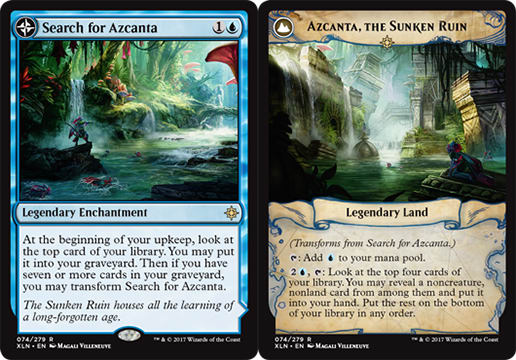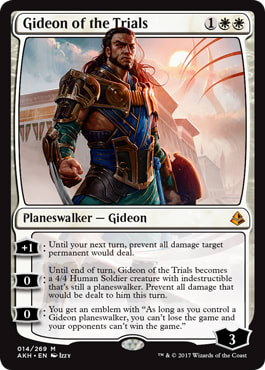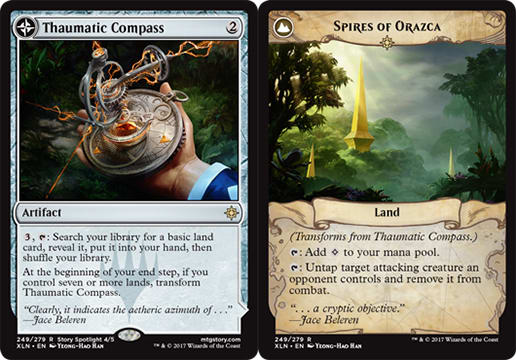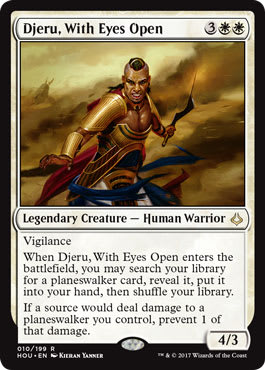Consider for a moment Huey Jensen’s World Championship-winning Temur Energy deck. Huey chose not to play The Scarab God, a Black splash then-recently originated, and immediately widely adopted.
The Scarab God is considered by many to be the best card in Standard. How can it be that cutting the best card in the format could make for a better deck?
Huey wanted to play only 22 lands, rather than the 23 necessitated by adding a Swamp. This was a seemingly small change. Not only was Hall of Famer’s mana better than those playing Four-color Energy, he got a slot back, which became a Commit // Memory surprisingly pivotal in his undefeated first day.
I think you’ll agree that cutting a single basic land in order to smooth out the mana balance (and make room for a couple of roguish Blue instants) looks like a small change. But seemingly small changes can often make for profound differences in performance. But like a virus, it is sometimes the very small tweak that knocks the opponent out for a week. Consider:
Demystify
Since Ixalan came legal in Standard, there have been one World Championship, the US National Championship, one Standard Open and three SCG Classics. Demystify made zero Top 8 appearances. Zero! This is less a sign that the card isn’t good than that it is currently radically underpriced; translation: You’ll get more mileage out of playing Demystify now than you actually should. And it is obviously good enough.
Where does Demystify shine? There are two-and-a-half key places.
1. B/U Control
Consider the structure of Oliver Tomajko’s ![]()
![]() Control deck: Four copies of Hieroglyphic Illumination main deck; zero copies of Glimmer of Genius deck or sideboard. The message here is clear: Cards have been selected specifically in deference to Search for Azcanta.
Control deck: Four copies of Hieroglyphic Illumination main deck; zero copies of Glimmer of Genius deck or sideboard. The message here is clear: Cards have been selected specifically in deference to Search for Azcanta.
Search for Azcanta is an interesting card. Not only is it powerful enough that the top deck designers in the world (and the US National Champion, paying homage to them) will bend convention around it, tactually players will tend to over-value opening hands that include it. For instance, you might keep an otherwise weak hand that can play a second turn Search for Azcanta under the reliance that it will fix your future draws.
Hieroglyphic Illumination is stronger than Glimmer of Genius in Search for Azcanta decks because one mana to put a card in the graveyard is of outsized value in a deck trying to ramp into Azcanta, the Sunken Ruin. The Phase II version of Search for Azcanta can make up for the lack of Glimmer of Genius itself, going long.
How does Demystify fit in?
Easy! A 1-mana one-for-one to interact with the opponent’s 2-mana bomb is an easy trade whenever you can get it.
But no one would play — or at least seems to be interested in playing — Demystify just for Search for Azcanta. Consider . . .
2. Approach of the Second Sun
Well, not Approach itself. Rather, the Approach meta-game.
If you look at Approach of the Second Sun decks over time, you will notice a wider and wider adoption of Gideon of the Trials. The initial builds under Dan Ward played no copies deck or sideboard; two started to become more common; most recently we’ve seen as many as all four copies of Gideon of the Trials main deck!
The reason for this is twofold. First, Gideon is awesome in a deck that plays a lot of Fumigate and / or Settle the Wreckage. Gideon can lock down the first threat, forcing the opponent to commit into your sweeper.
But against [another] Approach deck, Gideon’s emblem becomes very important. While you are protected by Gideon’s emblem — so long as you have a Gideon Planeswalker on the battlefield — you cannot be defeated by the opponent casting Approach of the Second Sun.
An Approach player knowing this will have to set you up prior to going for the kill. Typically this entails removing your Gideon from the battlefield at the end of your turn with a Cast Out. Now you have a deck with at least Approach of the Second Sun (![]() ) on one side of the table, and a deck with at least Gideon of the Trials (
) on one side of the table, and a deck with at least Gideon of the Trials (![]()
![]() ) on the other. It is not out of the question for there to be 6-8 copies of Cast Out between the two decks.
) on the other. It is not out of the question for there to be 6-8 copies of Cast Out between the two decks.
The meta-game now involves 1) Gideon of the Trials, 2) Cast Out for Gideon to set up Approach of the Second Sun, and 3) Cast Out for the opponent’s Cast Out (effectively countering the second Approach of the Second Sun). Whew! Got all that?
How does Demystify fit in?
The math is hard enough given one or both of you might have to cycle a Cast Out to hit land or action. It really does come down to Cast Out on top of Cast Out, possibly fueled by Azcanta, the Sunken Ruin.
Demystify is just another point of interaction — but here for a fight that will almost certainly occur, given the length of games — and one that can be fought cheaply enough that you can reliably cast it on the same turn as your second Approach. This comes up a lot for players who successfully Cast Out Gideon of the Trials but expose themselves the following turn by tapping 7+ mana.
3. W/B Tokens
Take Out Anointed Procession — for one no less! — and there isn’t much between Anointer Priest and filling out the match slip.
Thaumatic Compass
Like Demystify, Thaumatic Compass is an awesome card . . . That has seen zero play in any Top 8 we’ve seen thus far. Unlike Demystify, Thaumatic Compass is a powerhouse on its own . . . Just misunderstood at this point.
Thaumatic Compass is extraordinarily powerful; just not very good against Ramunap Red. Going medium-long it’s serviceable against Approach, actively great against Temur Energy, and nigh unbeatable for ![]()
![]() Control.
Control.
In general, this is a card that acts like a flipped Search for Azcanta . . . Only before it, itself, flips. That’s why it’s bad against Ramunap Red: Not only is it a neon colored Abrade target, you can’t afford to be searching early against them while they are bearing down with haste creatures.
Against ![]()
![]() or
or ![]()
![]() though? Whatever your color combination, this is a card that will help you keep pace with their card draw, and quite mana efficiently. It might not seem intuitive, but control decks can draw up to 8+ cards but miss land drops when using specialists like Azcanta, the Sunken Ruin; what they actually want is land, but they keep drawing bad creature removal!
though? Whatever your color combination, this is a card that will help you keep pace with their card draw, and quite mana efficiently. It might not seem intuitive, but control decks can draw up to 8+ cards but miss land drops when using specialists like Azcanta, the Sunken Ruin; what they actually want is land, but they keep drawing bad creature removal!
Thaumatic Compass helps you keep pace with their cardboard advantage, if not quality of cards.
That’s okay, once it flips, you cut them off at the pass!
Here’s the thing about a ![]()
![]() Control deck: It doesn’t actually matter how much potential card advantage The Scarab God can create; they can field no more than 4 threats the entire game! That is because The Scarab God is itself Legendary; so if they get all their Torrential Gearhulks and The Scarab God over the course of many, many turns but you can keep pace with up to four Thaumatic Compasses, they can’t actually win. Crazy, right?
Control deck: It doesn’t actually matter how much potential card advantage The Scarab God can create; they can field no more than 4 threats the entire game! That is because The Scarab God is itself Legendary; so if they get all their Torrential Gearhulks and The Scarab God over the course of many, many turns but you can keep pace with up to four Thaumatic Compasses, they can’t actually win. Crazy, right?
You’ll still need something. You’ll need to be opportunistic with Field of Ruin or they might long game you with their Field of Ruin. It will depend on what archetype you are as to how you plan to pin The Scarab God long-term. But Thaumatic Compass will surprise you, I think. It has been no less than awesome in my testing.
It’s great against Temur, too; especially in Gideon decks. Instead of forcing a two-for-one, this helps force the three-for-one and implies the next two — or three-for-one. They can’t even flash-haste recover with Glorybringer the way they can against Gideon; Spires of Orazca will be untapped and waiting.
And no, before you bother looking, Spires of Orazca is not Legendary. I know! I know!
Djeru, With Eyes Open
Finally, the half-card.
Half only because Djeru is not an Ixalan newcomer; it is, however, equally not-played and nearly as awesome as the other two cards.
I initially got excited to try Djeru due to the printing of Huatli, Warrior Poet (ooh, I can make a Planeswalker Control deck!) but got dissuaded by all the main deck Essence Scatters. Djeru is great, but I think mostly as a sideboard card. In a creature-poor (but not creature-less) deck, Djeru will just always be on the wrong side of a two-for-five exchange. Anyway, you want him for particular fights, not in general.
I mean for five your opponents are going to have The Scarab God or Glorybringer, both of which out-class Djeru. You want this card for surgery, not bludgeoning.
But where to perform this surgery?
1. Approach of the Second Sun
Again, we have a card that is great against Approach. Why? You can play as few as one copy of Gideon of the Trials, and Djeru can help you set it up. Remember that whole rigamarole above with the Approach-Gideon meta-game? That only works if you’re presenting a Gideon the opponent is forced to interact with. Well, Djeru helps ensure that happens to begin with.
2. W/B Tokens
The ![]()
![]() Tokens deck has no efficient way to interact with Djeru, especially if not faced with many creatures main deck. It is a target for Vraska, Relic Seeker sure . . . But almost nothing else is good. Do you really want to tap five into the opponent’s five for Fumigate? Do you even have Fumigate in your deck at this point? Fatal Push can’t target Djeru . . . And both Cast Out and Angel of Sanctions have deadly downsides. Like, what happens when the Djeru player removes your Cast Out and he gets an incremental Djeru trigger?
Tokens deck has no efficient way to interact with Djeru, especially if not faced with many creatures main deck. It is a target for Vraska, Relic Seeker sure . . . But almost nothing else is good. Do you really want to tap five into the opponent’s five for Fumigate? Do you even have Fumigate in your deck at this point? Fatal Push can’t target Djeru . . . And both Cast Out and Angel of Sanctions have deadly downsides. Like, what happens when the Djeru player removes your Cast Out and he gets an incremental Djeru trigger?
I know. I know!
Horrible.
So the ![]()
![]() opponent isn’t great at removing Djeru, With Eyes Open. Got it. Why should he care?
opponent isn’t great at removing Djeru, With Eyes Open. Got it. Why should he care?
To understand this, you have to think about all the stuff Djeru does.
Djeru basically has three things going for it:
- Planeswalker Tutor
- Medium body for five
- One point damage blunting
All three abilities shine against ![]()
![]() .
.
First of all, you are getting a Planeswalker. Their primary way to keep the Planeswalker from hitting Ultimate is token attacks. Only Djeru turns off the token damage to Planeswalkers.
Mix this up with some Authority of the Consuls you were going to sideboard in anyway and you have quite the conundrum for ![]()
![]() Tokens. How exactly are they supposed to win before your Planeswalker goes Ultimate? Does it actually matter if they have Anointed Procession in play?
Tokens. How exactly are they supposed to win before your Planeswalker goes Ultimate? Does it actually matter if they have Anointed Procession in play?
Gross, right?
I predict all these cards to perform in Standard, or at least pick up from their current zero-levels.
As for me, I’ll be playing Modern this week. Inspiring Vantage in every format. Wish me luck!
LOVE
MIKE
































